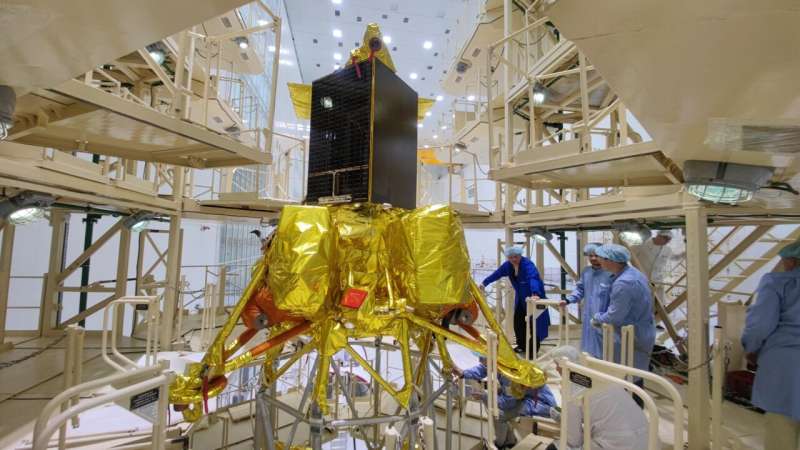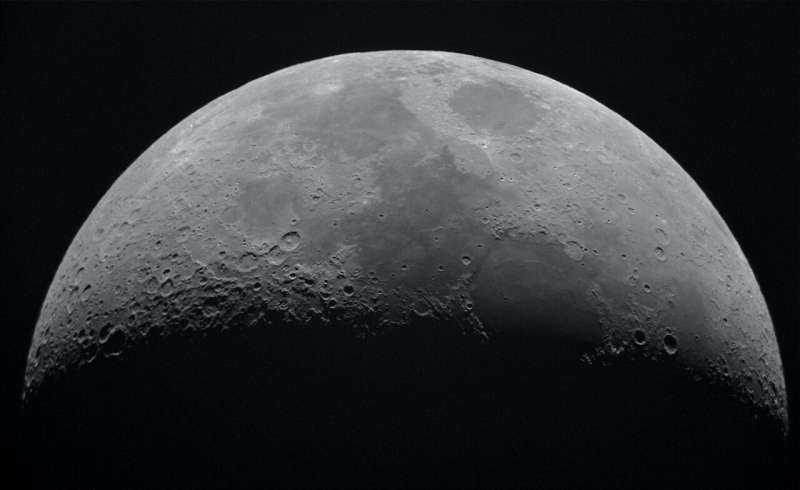
Copernical Team
Russia's Luna-25 probe crashes on the Moon

The Luna-25 probe, Russia's first Moon mission in almost 50 years, has crashed on the Moon after an incident during pre-landing maneuvers, Russian space agency Roscosmos said on Sunday.
Communication with Luna-25 was lost at 2:57 pm (1157 GMT) on Saturday, Roscosmos said.
According to preliminary findings, the lander "has ceased to exist following a collision with the Moon's surface", Roscosmos said.
"Measures taken on August 19 and 20 to locate the craft and make contact with it were unsuccessful."
The space agency said an investigation would be launched into the causes of the crash, without giving any indication of what technical problems might have occurred.
With Luna-25, Moscow had hoped to build on the legacy of its Soviet-era Luna program, marking a return to independent lunar exploration in the face of growing isolation from the West.
The 800-kilogram Luna-25 probe was to have made a soft landing on the lunar south pole, the first in history.
Russia has not attempted to land on a celestial body since 1989, when the Soviet Union's ill-fated Phobos 2 probe to explore the moons of Mars failed due to an onboard computer malfunction.
A new approach to reduce the risk of losing solar-powered rovers on the moon

Could artificially dimming the sun prevent ice melt
 With methods of so-called geoengineering, the climate could theoretically be artificially influenced and cooled. Bernese researchers have now investigated whether it would be possible to prevent the melting of the West Antarctic ice sheet by artificially "dimming the sun". The results show that artificial influence does not work without decarbonization and entails high risks.
Is there an e
With methods of so-called geoengineering, the climate could theoretically be artificially influenced and cooled. Bernese researchers have now investigated whether it would be possible to prevent the melting of the West Antarctic ice sheet by artificially "dimming the sun". The results show that artificial influence does not work without decarbonization and entails high risks.
Is there an e Russia's Luna-25 probe crashes on the Moon: Roscosmos
 The Luna-25 probe, Russia's first Moon mission in almost 50 years, has crashed on the Moon after an incident during pre-landing manoeuvres, Russian space agency Roscosmos said on Sunday.
Communication with Luna-25 was lost at 2:57 pm (1157 GMT) on Saturday, Roscosmos said.
According to preliminary findings, the lander "has ceased to exist following a collision with the Moon's surface".
The Luna-25 probe, Russia's first Moon mission in almost 50 years, has crashed on the Moon after an incident during pre-landing manoeuvres, Russian space agency Roscosmos said on Sunday.
Communication with Luna-25 was lost at 2:57 pm (1157 GMT) on Saturday, Roscosmos said.
According to preliminary findings, the lander "has ceased to exist following a collision with the Moon's surface". Emergency detected in pre-moon landing maneuver by Russia's Luna-25 probe

An "emergency" was detected on Saturday during a maneuver by Russia's Luna-25 probe prior to its Moon landing, Russian space agency Roscosmos said.
"Thrust was released to transfer the probe onto the pre-landing orbit," Roscosmos said in a statement.
"During the operation, an emergency situation occurred on board the automatic station, which did not allow the carrying out of the maneuver within the specified conditions."
The lander, Russia's first such mission in almost 50 years, was successfully placed in the Moon's orbit on Wednesday after being launched from the Vostochny cosmodrome in the country's Far East.
Roscosmos did not say if the incident would delay the landing, due to take place on Monday, north of the Boguslawsky crater on the lunar south pole.
In June, Roscosmos chief Yuri Borisov told President Vladimir Putin that such missions were "risky", with an estimated success probability of around 70 percent.
The probe is expected to stay on the Moon for a year, where it is tasked with collecting samples and analyzing soil.
Cameras installed on the lander have already taken distant shots of the Earth and Moon from space.
Hurricane Hilary Barrels Toward Baja California
 Hurricane Hilary, a category 4 storm in the Pacific Ocean, approached the Baja California peninsula on August 18, 2023.
The Visible Infrared Imaging Radiometer Suite (VIIRS) on the NOAA-20 satellite acquired this image of Hilary in the predawn hours of August 18 (09:25 Universal Time), when the eye of the storm was about 400 miles (640 kilometers) off the coast of the peninsula. The image
Hurricane Hilary, a category 4 storm in the Pacific Ocean, approached the Baja California peninsula on August 18, 2023.
The Visible Infrared Imaging Radiometer Suite (VIIRS) on the NOAA-20 satellite acquired this image of Hilary in the predawn hours of August 18 (09:25 Universal Time), when the eye of the storm was about 400 miles (640 kilometers) off the coast of the peninsula. The image From rice to quantum gas: China's targets pioneering space research
 China's orbiting Tiangong space station is now fully operational and has embarked on a mission that aims to achieve groundbreaking scientific discoveries, according to the China Manned Space Agency (CMSA). This marks a significant step forward as the station enters an application and development phase that is anticipated to last for over a decade.
The spokesperson for CMSA, Lin Xiqiang, re
China's orbiting Tiangong space station is now fully operational and has embarked on a mission that aims to achieve groundbreaking scientific discoveries, according to the China Manned Space Agency (CMSA). This marks a significant step forward as the station enters an application and development phase that is anticipated to last for over a decade.
The spokesperson for CMSA, Lin Xiqiang, re True Anomaly opens GravityWorks; gains federal clearances for space operations
 In a major advancement for space access and sustainability, tech firm True Anomaly, Inc. launched its advanced spacecraft manufacturing facility, GravityWorks, while simultaneously securing federal permissions for novel space operations.
Located in Centennial, Colo., this new facility positions True Anomaly amidst the flourishing aerospace and defense sectors of Colorado, one of America's
In a major advancement for space access and sustainability, tech firm True Anomaly, Inc. launched its advanced spacecraft manufacturing facility, GravityWorks, while simultaneously securing federal permissions for novel space operations.
Located in Centennial, Colo., this new facility positions True Anomaly amidst the flourishing aerospace and defense sectors of Colorado, one of America's Scientists use FAST to discover a new population of 'dwarf' pulses
 Using the Five-hundred-meter Aperture Spherical radio Telescope (FAST), a research team led by Prof. HAN Jinlin from the National Astronomical Observatories of the Chinese Academy of Sciences (NAOC) has detected distinct "dwarf pulses" from a bright pulsar PSR B2111+46, and studied the radio emission in unprecedented details and probed the unknown physics in the magnetosphere.
Pulsars gene
Using the Five-hundred-meter Aperture Spherical radio Telescope (FAST), a research team led by Prof. HAN Jinlin from the National Astronomical Observatories of the Chinese Academy of Sciences (NAOC) has detected distinct "dwarf pulses" from a bright pulsar PSR B2111+46, and studied the radio emission in unprecedented details and probed the unknown physics in the magnetosphere.
Pulsars gene Astronomers find progenitor of magnetic monster
 A team of researchers, including NOIRLab astronomer Andre-Nicolas Chene, has found a highly unusual star that has the most powerful magnetic field ever found in a massive star - and that may become one of the most magnetic objects in the Universe: a variant of a neutron star known as a magnetar. This finding marks the discovery of a new type of astronomical object - a massive magnetic helium sta
A team of researchers, including NOIRLab astronomer Andre-Nicolas Chene, has found a highly unusual star that has the most powerful magnetic field ever found in a massive star - and that may become one of the most magnetic objects in the Universe: a variant of a neutron star known as a magnetar. This finding marks the discovery of a new type of astronomical object - a massive magnetic helium sta 
































